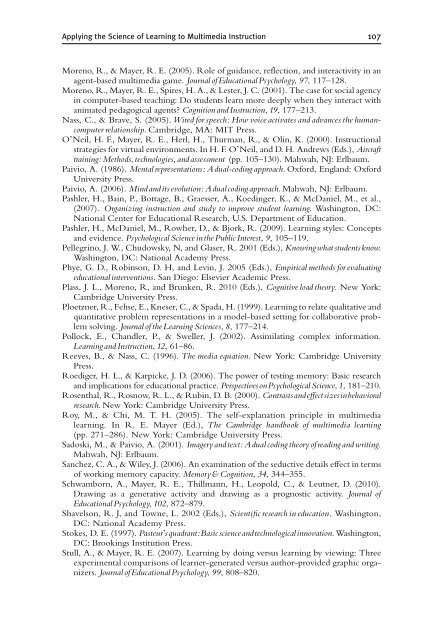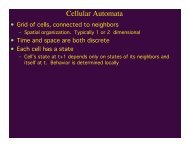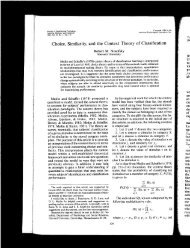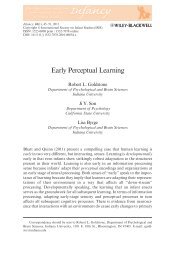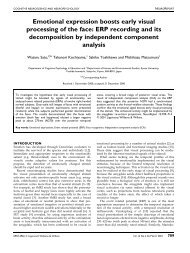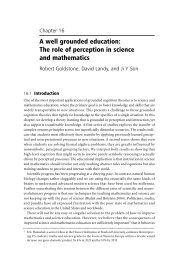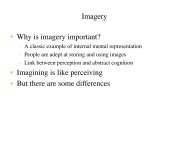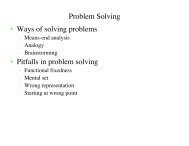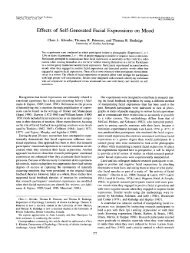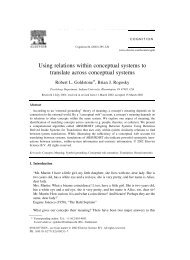Applying <strong>the</strong> Science <strong>of</strong> Learning to Multimedia Instruction 107Moreno, R., & Mayer, R. E. (2005). Role <strong>of</strong> guidance, reflection, <strong>and</strong> interactivity in anagent-based multimedia game. Journal <strong>of</strong>EducationalPsychology, 97, 117–128.Moreno, R., Mayer, R. E., Spires, H. A., & Lester, J. C. (2001). The case for social agencyin computer-based teaching: Do students learn more deeply when <strong>the</strong>y interact withanimated pedagogical agents? Cognition <strong>and</strong>Instruction, 19, 177–213.Nass, C., & Brave, S. (2005). Wired for speech: How voice activates <strong>and</strong> advances <strong>the</strong> humancomputerrelationship. Cambridge, MA: MIT Press.O’Neil, H. F., Mayer, R. E., Herl, H., Thurman, R., & Olin, K. (2000). Instructionalstrategies for virtual environments. In H. F. O’Neil, <strong>and</strong> D. H. Andrews (Eds.), Aircrafttraining: Methods,technologies, <strong>and</strong>assessment (pp. 105–130). Mahwah, NJ: Erlbaum.Paivio, A. (1986). Mentalrepresentations: A dual-coding approach. Oxford, Engl<strong>and</strong>: OxfordUniversity Press.Paivio, A. (2006). Mind<strong>and</strong>itsevolution:Adualcodingapproach.Mahwah, NJ: Erlbaum.Pashler, H., Bain, P., Bottage, B., Graesser, A., Koedinger, K., & McDaniel, M., et al.,(2007). Organizing instruction <strong>and</strong> study to improve student <strong>learning</strong>. Washington, DC:National Center for Educational Research, U.S. Department <strong>of</strong> Education.Pashler, H., McDaniel, M., Rowher, D., & Bjork, R. (2009). Learning styles: <strong>Concepts</strong><strong>and</strong> evidence. PsychologicalScience in<strong>the</strong> PublicInterest, 9, 105–119.Pellegrino, J. W., Chudowsky, N, <strong>and</strong> Glaser, R. 2001 (Eds.), Knowingwhatstudentsknow.Washington, DC: National Academy Press.Phye, G. D., Robinson, D. H, <strong>and</strong> Levin, J. 2005 (Eds.), Empirical methods for evaluatingeducationalinterventions. San Diego: Elsevier Academic Press.Plass, J. L., Moreno, R, <strong>and</strong> Brunken, R. 2010 (Eds.), Cognitive load <strong>the</strong>ory. New York:Cambridge University Press.Ploetzner, R., Fehse, E., Kneser, C., & Spada, H. (1999). Learning to relate qualitative <strong>and</strong>quantitative problem representations in a model-based setting for collaborative problemsolving. Journal<strong>of</strong> <strong>the</strong>LearningSciences, 8, 177–214.Pollock, E., Ch<strong>and</strong>ler, P., & Sweller, J. (2002). Assimilating complex information.Learning<strong>and</strong>Instruction, 12, 61–86.Reeves, B., & Nass, C. (1996). The media equation. New York: Cambridge UniversityPress.Roediger, H. L., & Karpicke, J. D. (2006). The power <strong>of</strong> testing memory: Basic research<strong>and</strong> implications for educational practice. PerspectivesonPsychologicalScience, 1, 181–210.Rosenthal, R., Rosnow, R. L., & Rubin, D. B. (2000). Contrasts<strong>and</strong>e¡ectsizesinbehavioralresearch.New York: Cambridge University Press.Roy, M., & Chi, M. T. H. (2005). The self-explanation principle in multimedia<strong>learning</strong>. In R. E. Mayer (Ed.), The Cambridge h<strong>and</strong>book <strong>of</strong> multimedia <strong>learning</strong>(pp. 271–286). New York: Cambridge University Press.Sadoski, M., & Paivio, A. (2001). Imagery<strong>and</strong> text: A dualcoding <strong>the</strong>ory<strong>of</strong>reading<strong>and</strong> writing.Mahwah, NJ: Erlbaum.Sanchez, C. A., & Wiley, J. (2006). An examination <strong>of</strong> <strong>the</strong> seductive details effect in terms<strong>of</strong> working memory capacity. Memory& Cognition, 34, 344–355.Schwamborn, A., Mayer, R. E., Thillmann, H., Leopold, C., & Leutner, D. (2010).Drawing as a generative activity <strong>and</strong> drawing as a prognostic activity. Journal <strong>of</strong>EducationalPsychology, 102, 872–879.Shavelson, R. J, <strong>and</strong> Towne, L. 2002 (Eds.), Scienti¢c research in education. Washington,DC: National Academy Press.Stokes, D. E. (1997). Pasteur’squadrant:Basicscience<strong>and</strong>technologicalinnovation.Washington,DC: Brookings Institution Press.Stull, A., & Mayer, R. E. (2007). Learning by doing versus <strong>learning</strong> by viewing: Threeexperimental comparisons <strong>of</strong> learner-generated versus author-provided graphic organizers.Journal<strong>of</strong> EducationalPsychology, 99, 808–820.
108 Richard E. MayerSweller, J. (1999). Instructional design in technical areas. Camberwell, Australia: ACERPress.Sweller, J. (2005a). Implications <strong>of</strong> cognitive load <strong>the</strong>ory for multimedia <strong>learning</strong>. In R. E.Mayer (Ed.), The Cambridge h<strong>and</strong>book <strong>of</strong> multimedia <strong>learning</strong> (pp. 19–30). New York:Cambridge University Press.Sweller, J. (2005b). The redundancy principle in multimedia <strong>learning</strong>. In R. E. Mayer(Ed.), The Cambridge h<strong>and</strong>book <strong>of</strong> multimedia <strong>learning</strong> (pp. 159–168). New York:Cambridge University Press.Tabbers, T. K., Martens, R. L., & van Merrienboer, J. J. G. (2004). Multimedia instructions<strong>and</strong> cognitive load <strong>the</strong>ory: Effects <strong>of</strong> modality <strong>and</strong> cueing. British Journal <strong>of</strong>Educational Psychology, 74, 71–81.Tindall-Ford, S., Ch<strong>and</strong>ler, P., & Sweller, J. (1997). When two sensory modes are betterthan one. Journal <strong>of</strong>ExperimentalPsychology: Applied, 3, 257–287.Wang, N., Johnson, W. L., Mayer, R. E., Rizzo, P., Shaw, E., & Collins, H. (2008). Thepoliteness effect: Pedagogical agents <strong>and</strong> <strong>learning</strong> outcomes. International Journal <strong>of</strong>Human Computer Studies, 66, 96–112.Wentzel, K. R, <strong>and</strong> Wigfield, A. 2009 (Eds.), H<strong>and</strong>book<strong>of</strong> <strong>motivation</strong> at school. New York:Routledge.Wittrock, M. C. (1989). Generative processes <strong>of</strong> comprehension. EducationalPsychologist,24, 345–376.
- Page 3 and 4:
Series EditorBRIAN H. ROSSBeckman I
- Page 5 and 6:
Academic Press is an imprint of Els
- Page 7 and 8:
viContents3. Science of Multimedia
- Page 9 and 10:
This Page Intentionally Left Blank
- Page 11 and 12:
xContributorsHenry L. Roediger, III
- Page 13 and 14:
xiiPrefaceand there has been much e
- Page 15 and 16:
xivPrefaceInterventions for improvi
- Page 17 and 18:
2 Henry L. Roediger et al.delayed t
- Page 19 and 20:
4 Henry L. Roediger et al.an indire
- Page 21 and 22:
6 Henry L. Roediger et al.[(Figure_
- Page 23 and 24:
8 Henry L. Roediger et al.[(Figure_
- Page 25 and 26:
10 Henry L. Roediger et al.seems so
- Page 27 and 28:
12 Henry L. Roediger et al.interpre
- Page 29 and 30:
14 Henry L. Roediger et al.Table 2
- Page 31 and 32:
16 Henry L. Roediger et al.improved
- Page 33 and 34:
18 Henry L. Roediger et al.this mat
- Page 35 and 36:
20 Henry L. Roediger et al.length o
- Page 37 and 38:
22 Henry L. Roediger et al.9. BENEF
- Page 39 and 40:
24 Henry L. Roediger et al.subjects
- Page 41 and 42:
26 Henry L. Roediger et al.feedback
- Page 43 and 44:
28 Henry L. Roediger et al.supporti
- Page 45 and 46:
30 Henry L. Roediger et al.of some
- Page 47 and 48:
32 Henry L. Roediger et al.Benefit
- Page 49 and 50:
34 Henry L. Roediger et al.Hasher,
- Page 51 and 52:
36 Henry L. Roediger et al.Son, L.
- Page 53 and 54:
38 John Sweller1. INTRODUCTIONCogni
- Page 55 and 56:
40 John Sweller‘‘baby-talk.’
- Page 57 and 58:
42 John Swellerof cognitive or meta
- Page 59 and 60:
44 John SwellerTable 1Natural Infor
- Page 61 and 62:
46 John Swellerconfigurations. A ch
- Page 63 and 64:
48 John Swellerreproduction results
- Page 65 and 66:
50 John Swellerto mutation, without
- Page 67 and 68:
52 John Swellerusing a complex or,
- Page 69 and 70:
54 John SwellerThe human cognitive
- Page 71 and 72: 56 John Swellerepigenetic system ha
- Page 73 and 74: 58 John SwellerWe can determine lev
- Page 75 and 76: 60 John Swellerthan memorizing the
- Page 77 and 78: 62 John SwellerTable 2EffectVariabi
- Page 79 and 80: 64 John Swelleroccurs when students
- Page 81 and 82: 66 John Sweller3.3.3. The Split-Att
- Page 83 and 84: 68 John Swellermerely restates the
- Page 85 and 86: 70 John SwellerThe expertise revers
- Page 87 and 88: 72 John Swellerobtained a reverse m
- Page 89 and 90: 74 John Swelleractivities that othe
- Page 91 and 92: 76 John SwellerRenkl, A. (2005). Th
- Page 93 and 94: 78 Richard E. Mayercognitive theory
- Page 95 and 96: 80 Richard E. Mayerpictures beginni
- Page 97 and 98: 82 Richard E. MayerThe dualchannelp
- Page 99 and 100: 84 Richard E. Mayerlearner selects
- Page 101 and 102: 86 Richard E. MayerRosenthal, Rosno
- Page 103 and 104: 88 Richard E. MayerGenerative proce
- Page 105 and 106: 90 Richard E. Mayer4.2. Evidence-ba
- Page 107 and 108: 92 Richard E. Mayersituation could
- Page 109 and 110: 94 Richard E. Mayer(Moreno & Mayer,
- Page 111 and 112: 96 Richard E. Mayer4.3.1. Segmentin
- Page 113 and 114: 98 Richard E. Mayerpresenting the w
- Page 115 and 116: 100 Richard E. MayerThe multimedia
- Page 117 and 118: 102 Richard E. Mayergame in industr
- Page 119 and 120: 104 Richard E. MayerClark, R. C., &
- Page 121: 106 Richard E. MayerMayer, R. E., &
- Page 125: 110 Timothy J. Nokes and Daniel M.
- Page 128 and 129: Incorporating Motivation into a The
- Page 130 and 131: Incorporating Motivation into a The
- Page 132 and 133: Incorporating Motivation into a The
- Page 134 and 135: Incorporating Motivation into a The
- Page 136 and 137: Incorporating Motivation into a The
- Page 138 and 139: Incorporating Motivation into a The
- Page 140 and 141: Incorporating Motivation into a The
- Page 142 and 143: Incorporating Motivation into a The
- Page 144 and 145: Incorporating Motivation into a The
- Page 146 and 147: Incorporating Motivation into a The
- Page 148 and 149: Incorporating Motivation into a The
- Page 150 and 151: Incorporating Motivation into a The
- Page 152 and 153: CHAPTERFIVEOn the Interplay of Emot
- Page 154 and 155: Implications for Enhancing Academic
- Page 156 and 157: Implications for Enhancing Academic
- Page 158 and 159: Implications for Enhancing Academic
- Page 160 and 161: Implications for Enhancing Academic
- Page 162 and 163: Implications for Enhancing Academic
- Page 164 and 165: Implications for Enhancing Academic
- Page 166 and 167: Implications for Enhancing Academic
- Page 168 and 169: Implications for Enhancing Academic
- Page 170 and 171: Implications for Enhancing Academic
- Page 172 and 173:
Implications for Enhancing Academic
- Page 174 and 175:
Implications for Enhancing Academic
- Page 176 and 177:
Implications for Enhancing Academic
- Page 178 and 179:
Implications for Enhancing Academic
- Page 180 and 181:
Implications for Enhancing Academic
- Page 182 and 183:
Implications for Enhancing Academic
- Page 184 and 185:
Implications for Enhancing Academic
- Page 186 and 187:
CHAPTERSIXThere Is Nothing So Pract
- Page 188 and 189:
There Is Nothing So Practical as a
- Page 190 and 191:
There Is Nothing So Practical as a
- Page 192 and 193:
There Is Nothing So Practical as a
- Page 194 and 195:
There Is Nothing So Practical as a
- Page 196 and 197:
There Is Nothing So Practical as a
- Page 198 and 199:
There Is Nothing So Practical as a
- Page 200 and 201:
There Is Nothing So Practical as a
- Page 202 and 203:
There Is Nothing So Practical as a
- Page 204 and 205:
There Is Nothing So Practical as a
- Page 206 and 207:
There Is Nothing So Practical as a
- Page 208 and 209:
There Is Nothing So Practical as a
- Page 210 and 211:
There Is Nothing So Practical as a
- Page 212 and 213:
There Is Nothing So Practical as a
- Page 214 and 215:
CHAPTERSEVENThe Power of Comparison
- Page 216 and 217:
The Power of Comparison in Learning
- Page 218 and 219:
The Power of Comparison in Learning
- Page 220 and 221:
The Power of Comparison in Learning
- Page 222 and 223:
The Power of Comparison in Learning
- Page 224 and 225:
The Power of Comparison in Learning
- Page 226 and 227:
The Power of Comparison in Learning
- Page 228 and 229:
The Power of Comparison in Learning
- Page 230 and 231:
The Power of Comparison in Learning
- Page 232 and 233:
The Power of Comparison in Learning
- Page 234 and 235:
The Power of Comparison in Learning
- Page 236 and 237:
The Power of Comparison in Learning
- Page 238 and 239:
The Power of Comparison in Learning
- Page 240 and 241:
The Power of Comparison in Learning
- Page 242 and 243:
CHAPTEREIGHTThe Ubiquitous Patterns
- Page 244 and 245:
The Ubiquitous Patterns of Incorrec
- Page 246 and 247:
The Ubiquitous Patterns of Incorrec
- Page 248 and 249:
The Ubiquitous Patterns of Incorrec
- Page 250 and 251:
The Ubiquitous Patterns of Incorrec
- Page 252 and 253:
The Ubiquitous Patterns of Incorrec
- Page 254 and 255:
The Ubiquitous Patterns of Incorrec
- Page 256 and 257:
The Ubiquitous Patterns of Incorrec
- Page 258 and 259:
The Ubiquitous Patterns of Incorrec
- Page 260 and 261:
The Ubiquitous Patterns of Incorrec
- Page 262 and 263:
The Ubiquitous Patterns of Incorrec
- Page 264 and 265:
The Ubiquitous Patterns of Incorrec
- Page 266 and 267:
The Ubiquitous Patterns of Incorrec
- Page 268 and 269:
The Ubiquitous Patterns of Incorrec
- Page 270 and 271:
The Ubiquitous Patterns of Incorrec
- Page 272 and 273:
The Ubiquitous Patterns of Incorrec
- Page 274 and 275:
The Ubiquitous Patterns of Incorrec
- Page 276 and 277:
The Ubiquitous Patterns of Incorrec
- Page 278 and 279:
The Ubiquitous Patterns of Incorrec
- Page 280 and 281:
The Ubiquitous Patterns of Incorrec
- Page 282 and 283:
The Ubiquitous Patterns of Incorrec
- Page 284 and 285:
CHAPTERNINEConceptual Problem Solvi
- Page 286 and 287:
Conceptual Problem Solving in Physi
- Page 288 and 289:
Conceptual Problem Solving in Physi
- Page 290 and 291:
Conceptual Problem Solving in Physi
- Page 292 and 293:
Conceptual Problem Solving in Physi
- Page 294 and 295:
Conceptual Problem Solving in Physi
- Page 296 and 297:
Conceptual Problem Solving in Physi
- Page 298 and 299:
Conceptual Problem Solving in Physi
- Page 300 and 301:
Conceptual Problem Solving in Physi
- Page 302 and 303:
Conceptual Problem Solving in Physi
- Page 304 and 305:
Conceptual Problem Solving in Physi
- Page 306 and 307:
Conceptual Problem Solving in Physi
- Page 308 and 309:
Conceptual Problem Solving in Physi
- Page 310 and 311:
Conceptual Problem Solving in Physi
- Page 312 and 313:
Conceptual Problem Solving in Physi
- Page 314 and 315:
IndexAAcademic performancedrive the
- Page 316 and 317:
Index 301Correct method comparison,
- Page 318 and 319:
Index 303LLabor in vain, 28Language
- Page 320 and 321:
Index 305OOntological categories of
- Page 322 and 323:
Index 307WWeb-delivered multimedia
- Page 324 and 325:
CONTENTS OF RECENT VOLUMESVolume 40
- Page 326 and 327:
Contents of Recent Volumes 311Under
- Page 328 and 329:
Contents of Recent Volumes 313Volum


